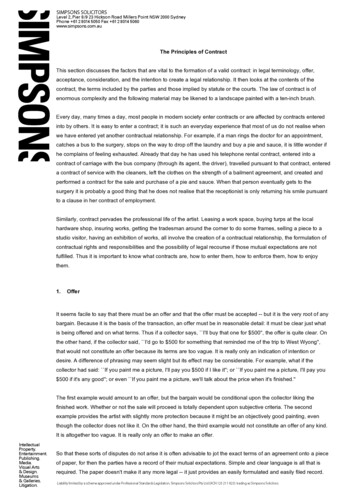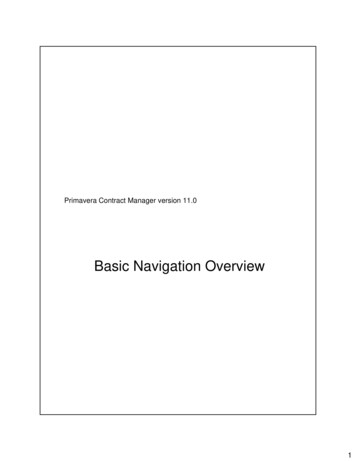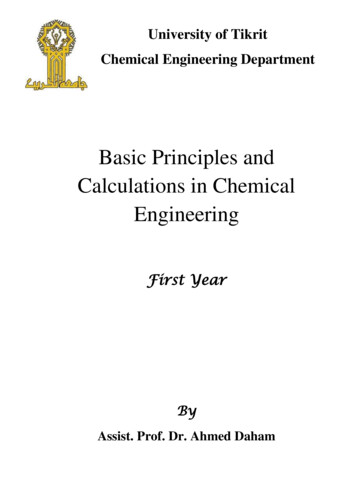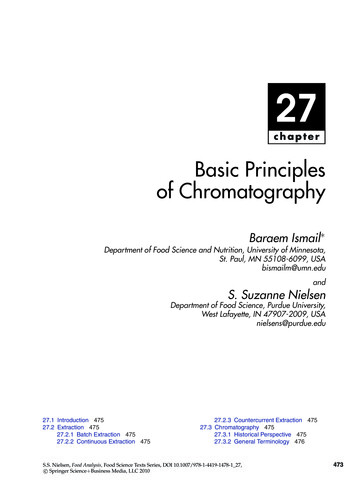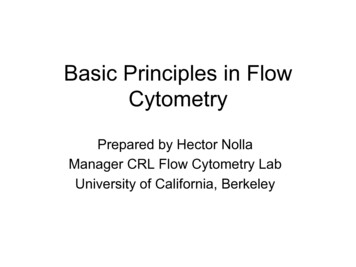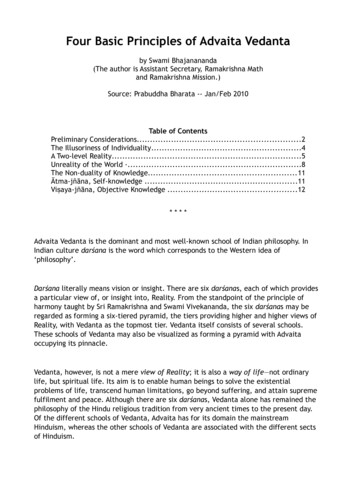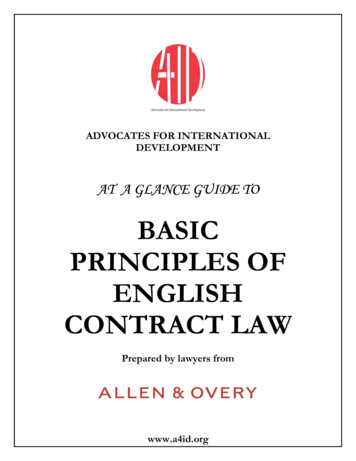
Transcription
ADVOCATES FOR INTERNATIONALDEVELOPMENTAT A GLANCE GUIDE TOBASICPRINCIPLES OFENGLISHCONTRACT LAWPrepared by lawyers fromwww.a4id.org
TABLE OF CONTENTSIFORMATION OF A CTUAL INTENTIONE.FORMIICONTENTS OF A CONTRACTA.EXPRESS TERMSB.IMPLIED TERMSIIITHE END OF A CONTRACT – EXPIRATION, TERMINATION, TIONDFRUSTRATIONVIDAMAGES / REMEDIES
BASIC PRINCIPLES OF ENGLISH CONTRACT LAWINTRODUCTIONThis Guide is arranged in the following parts:IFormation of a ContractIIContents of a ContractIIIThe end of a ContractIFORMATION OF A CONTRACT1.A contract is an agreement giving rise to obligations which are enforced orrecognised by law.2.In common law, there are 3 basic essentials to the creation of a contract: (i)agreement; (ii) contractual intention; and (iii) consideration.3.The first requisite of a contract is that the parties should have reachedagreement. Generally speaking, an agreement is reached when one partymakes an offer, which is accepted by another party. In deciding whether theparties have reached agreement, the courts will apply an objective test.A.OFFER4.An offer is an expression of willingness to contract on specified terms, madewith the intention that it is to be binding once accepted by the person towhom it is addressed.1 There must be an objective manifestation of intent bythe offeror to be bound by the offer if accepted by the other party. Therefore,the offeror will be bound if his words or conduct are such as to induce areasonable third party observer to believe that he intends to be bound, evenif in fact he has no such intention. This was held to be the case where auniversity made an offer of a place to an intending student as a result of aclerical error.25.An offer can be addressed to a single person, to a specified group of persons,or to the world at large. An example of the latter would be a reward poster forthe return of a lost pet.6.An offer may be made expressly (by words) or by conduct.7.An offer must be distinguished from an invitation to treat, by which a persondoes not make an offer but invites another party to do so. Whether astatement is an offer or an invitation to treat depends primarily on theintention with which it is made. An invitation to treat is not made with theintention that it is to be binding as soon as the person to whom it isaddressed communicates his assent to its terms. Common examples of12Stover v Manchester City Council [1974] 1 WLR 1403.Moran v University College Salford (No 2), The Times, November 23, 1993.
invitations to treat include advertisements3 or displays of goods on a shelf ina self-service store.48.The famous case of Carlill v Carbolic Smoke Ball Company [1893] 2 QB 256 isrelevant here. A medical firm advertised that its new drug, a carbolic smokeball, would cure flu, and if it did not, buyers would receive 100. When sued,Carbolic argued the advert was not to be taken as a legally binding offer; itwas merely an invitation to treat, a mere puff or gimmick. However, the Courtof Appeal held that the advertisement was an offer. An intention to be boundcould be inferred from the statement that the advertisers had deposited 1,000 in their bank "shewing our sincerity".B.ACCEPTANCE9.An acceptance is a final and unqualified expression of assent to the terms ofan offer. Again, there must be an objective manifestation, by the recipient ofthe offer, of an intention to be bound by its terms. An offer must be acceptedin accordance with its precise terms if it is to form an agreement. It mustexactly match the offer and ALL terms must be accepted.10.An offer may be accepted by conduct (for example, an offer to buy goods canbe accepted by sending them to the offeror).11.Acceptance has no legal effect until it is communicated to the offeror(because it could cause hardship to the offeror to be bound without knowingthat his offer had been accepted). The general rule is that a postal acceptancetakes effect when the letter of acceptance is posted5 (even if the letter maybe lost, delayed or destroyed6). However, the postal rule will not apply if it isexcluded by the express terms of the offer. An offer which requiresacceptance to be communicated in a specified way can generally be acceptedonly in that way. If acceptance occurs via an instantaneous medium such asemail, it will take effect at the time and place of receipt.7 Note that an offerorcannot stipulate that the offeree's silence amounts to acceptance.12.A communication fails to take effect as an acceptance where it attempts tovary the terms of an offer. In such cases it is a counter-offer, which theoriginal offeror can either accept or reject. For example, where the offeroroffers to trade on its standard terms and the offeree purports to accept, buton its own standard terms, that represents a counter-offer. Making a counteroffer amounts to a rejection of the original offer which cannot subsequentlybe restored or accepted (unless the parties agree).8 It is important todistinguish a counter-offer from a mere request for further informationregarding the original offer.13.An offer may be revoked at any time before its acceptance, however therevocation must be communicated to the offeree. Although revocation need345678Partridge v Crittenden [1968] 1 WLR 1204.Pharmaceutical Society of Great Britain v Boots Cash Chemist (Southern) Ltd [1953] 1 QB 410.Henthorn v Fraser [1892] 2 Ch 27.Adams v Lindsell [1818] 1 B & Ald 681.Entores v Miles Far East Corp [1955] 2 QB 327.Hyde v Wrency [1840] 3 Beav 334.
not be communicated by the offeror personally (it can be made by a reliablethird party), if it is not communicated, the revocation is ineffective.914.Once an offer has been accepted, the parties have an agreement. That is thebasis for a contract, but is not sufficient in itself to create legal obligations.C.CONSIDERATION15.In common law, a promise is not, as a general rule, binding as a contractunless it is supported by consideration (or it is made as a deed).Consideration is "something of value" which is given for a promise and isrequired in order to make the promise enforceable as a contract. This istraditionally either some detriment to the promisee (in that he may givevalue) and/or some benefit to the promisor (in that he may receive value).For example, payment by a buyer is consideration for the seller's promise todeliver goods, and delivery of goods is consideration for the buyer's promiseto pay. It follows that an informal gratuitous promise does not amount to acontract.Consideration must be sufficient, but need not be adequate16.Although a promise has no contractual force unless some value has beengiven for it, consideration need not be adequate. Courts do not, in generalask whether adequate value has been given (in the sense of there being anyeconomic equivalence between the value of the consideration given and thevalue of any goods or services received). This is because they do notnormally interfere with the bargain made between the parties10. Accordingly,nominal consideration is sufficient.Consideration must not be from the past17.The consideration for a promise must be given in return for the promise.Consideration must move from the promisee18.The promisee must provide the consideration. Tradditionally, a person towhom a promise was made can enforce it only if he himself provided theconsideration for it. He has no such right if the consideration moved from athird party. For example, if A promises B to pay 10,000 to B if C will paintA's house and C does so, B cannot enforce A's promise (unless B hadprocured or undertaken to procure C to do the work). However, where theconditions of the Contracts (Rights of Third Parties) Act 1999 are met, a thirdparty may be able to enforce rights created in his favour by a contract whichhe was not a party to, and the courts are also adopting a more flexibleposition under the common law here.19.While consideration must move from the promisee, it need not move to thepromisor. First, consideration may be satisfied where the promisee sufferssome detriment at the promisor's request but confers no correspondingbenefit on the promisor. For example, the promise to give up tenancy of a flat9Byrne v Van Tienhoven [1880] 5 CPD 344.There are a few exceptions, for example, where certain terms of a contract are void either by statute (for example, tenancyagreement) or where common law holds the terms to be so unreasonable that they cannot be enforced and/or are varied by the courts.10
may be adequate consideration even though no direct benefit results to thepromisor. Secondly, consideration may move from the promisee withoutmoving to the promisor where the promisee, at the promisor's request,confers a benefit on a third party. In situations where goods are bought witha credit card, the issuer makes a promise to the supplier that s/he will bepaid. The supplier provides consideration for this by providing goods to thecustomer.D.CONTRACTUAL INTENTION20.An agreement, even if supported by consideration, is not binding as acontract if it was made without an intention to create legal intentions. That is,the parties must intend their agreement to be legally binding.21.In the case of ordinary commercial transactions, there is a presumption thatthe parties intended to create legal relations. The onus of rebutting thispresumption is on the party who asserts that no legal effect was intended,and the onus is a heavy one.1122.Many social arrangements do not amount to contracts because they are notintended to be legally binding. Equally, many domestic arrangements, such asbetween husband and wife, or between parent and child, lack force becausethe parties did not intend them to have legal consequences. In Balfour vBalfour [1919] 2 KB 571, a husband who worked abroad promised to pay anallowance of 30 per month to his wife, who was in England. The wife'sattempt to enforce this promise failed: the parties did not intend thearrangement to be legally binding. (Note that in addition, the wife had notprovided any consideration.)23.An agreement which is made "subject to contract" (typically, agreements forthe sale of land) or a "letter of comfort" is generally unenforceable. The wordsnormally negate any contractual intention, so that the parties are not bounduntil formal contracts are exchanged.E.FORM1.The general rule is that contracts can be made informally; most contracts canbe formed orally, and in some cases, no oral or written communication at allis needed. Thus, an informal exchange of promises can still be as binding andlegally valid as a written contract. There are statutory exceptions to this rule.For example: (i) a lease for more than 3 years must be made by deed: Law ofProperty Act 1925, ss 52, 54(2); (ii) most contracts for the sale or dispositionof an interest in land must be "made in writing": Law of Property(Miscellaneous Provisions) Act 1989, s 2; (iii) contracts of guarantee arerequired to be evidenced in writing: Statute of Frauds, s 4.IICONTENTS OF A CONTRACTThe terms of a contract can be divided into express terms and implied terms.A.11EXPRESS TERMSEdwards v Skyways Ltd [1964] 1 WLR 349.
1.Express terms are ones that the parties have set out in their agreement.2.The parties may record their agreement, and hence the terms of theircontract, in more than one document. Those terms may be incorporated byreference into the contract; (for example, where a contract is made subject tostandard terms drawn up by a relevant trading association). Or, a contractmay be contained in more than one document even though one does notexpressly refer to the other (for example, dealings which take place under a'master contract' with a separate document being executed every time anindividual contract is made). Here, the master contract lays out most of theunderlying terms on which the parties are dealing, while certain specific terms– price, times for delivery etc – are covered in individual contracts for eachspecific trade. Incorporation without express reference depends on theintention of the parties, determined in accordance with the objective test ofagreement.3.Once the express terms have been identified, there is the question ofinterpretation. The document setting out the parties' agreement must beinterpreted objectively: it is not a question of what one party actuallyintended or what the other party actually understood to have been intendedbut of what a reasonable person in the position of the parties would haveunderstood the words to mean. The starting point for ascertaining theobjective meaning is the words used by the parties. These are interpretedaccording to their meaning in conventional usage, unless there is somethingin the background showing that some other meaning would have beenconveyed to the reasonable person. Thus, the terms of the contract must beread against the "factual matrix"; that is, the body of facts reasonablyavailable to both parties when they entered the contract.124.The "parol evidence" rule provides that evidence cannot be admitted to addto, vary or contradict a written document. Therefore, where a contract hasbeen put in writing, there is a presumption that the writing was intended toinclude all the terms of the contract, and neither party can rely on extrinsicevidence of terms alleged to have been agreed which are not contained in thedocument. This presumption is rebuttable, and extrinsic evidence isadmissible, if the written document was not intended to set out all the termson which the parties had agreed. The parol evidence rule prevents a partyfrom relying on extrinsic evidence only about the contents of a contract (andonly express terms), and not about its validity (such as the presence orabsence of consideration or contractual intention, or where a contract isinvalid for a reason such as incapacity).B.IMPLIED TERMS5.A contract may contain terms which are not expressly stated but which areimplied, e
In common law, a promise is not, as a general rule, binding as a contract unless it is supported by consideration (or it is made as a deed). Consideration is "something of value" which is given for a promise and is required in order to make the promise enforceable as a contract. This is traditionally either some detriment to the promisee (in that he may give value) and/or some benefit to the .




